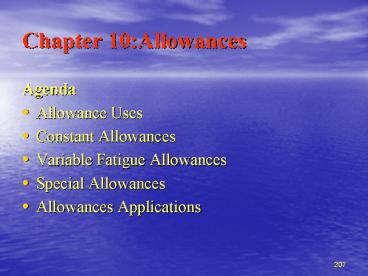Chapter 10:Allowances PowerPoint PPT Presentation
1 / 17
Title: Chapter 10:Allowances
1
Chapter 10Allowances
- Agenda
- Allowance Uses
- Constant Allowances
- Variable Fatigue Allowances
- Special Allowances
- Allowances Applications
2
Allowances Uses
- Allowances for unavoidable delay (oil
machine, wait for inspector, tool maintenance)
and other lost time (start work late, talk to
other, search for tools) - Typical industrial allowances
- Requirements accurate and correct
- Use
- Total cycle time
- Machine time
- Manual effort time
- Method to develop standard allowance data
- Production study requires complete observation
over a long period of time ? tedious, bias
results - Work sampling study
3
(No Transcript)
4
Work Sampling
- Requires a large of random observations
- No use of a stopwatch is necessary
- Observers merely walk through at
and simply records what each operator is doing
5
Allowances by function
6
Constant Allowances
- Personal needs cessations in work
- Those interruptions necessary to the employee
- drinking, washing, go to restroom, etc
- Can be a function of the working environment
- Typically
- Basic fatigue account for the energy expended to
carry out the work and to alleviate monotony,
typically of normal time for an operator who is
doing light work, seated, under good working
conditions, no special demands
7
Variable Fatigue Allowances
- Basic principles
- Lessening of the will to work
- Can be mental or physical, or a combined effect
- Factors include Noise, heat, humidity, posture,
muscular exertion, tediousness, general health of
the worker - Determination of fatigue allowance
- Use the ILO guidelines
- Measure the in production throughout the
working period F (T-t) x 100/T - where
- F coefficient of fatigue
- T time required to perform the operation at
the end of continuous work - t time required to perform the operation at
the beginning of continuous work
8
(No Transcript)
9
Detail Considerations of Factors
- Abnormal posture metabolic models sitting,
standing and bending - Muscular force time vs. exertion level recovery
- RA 1800 x (t/T)1.4 x (f/F 0.15)0.5
- where RA relaxation allowances in percent of
time t - t duration of holding time (minutes)
- f holding force (pounds)
- F maximum holding force (pounds)
- T maximum holding time for holding force f
(min) - T 1.2/(f/F 0.15)0.618 1.21
10
(No Transcript)
11
Detail Considerations of Factors
- Time required for rest R (W-5.33)/(W-1.33),
total time - W average energy expenditure during work
(kcal/min) - Muscular energy RA (?W/4 1) x 100
- RA relaxation allowances in percent added to
normal time - ?W energy expenditure increment for work
W-1.33, kcal/min - Heart Rate RA (?HR/40 1) x 100
- RA relaxation allowances in percent added to
normal time - ?HR Difference between working heart rate and
resting heart rate
12
Detail Considerations of Factors
- Atmospheric conditions RA e(- 41.5 0.0161W
0.497WBGT) - where W working energy expenditure
- WBGT wet-bulb globe temperature (0F)
- Noise level D C1/T1 C2/T2
- where D noise dose (decimal value)
- C time spent at specified noise level
(hours) - T time permitted at specified level (hours)
- And RA 100 x (D-1)
- Illumination levels
- Time 251.8 33.96logFC 6.15(logFC)2
0.37(logFC)3 - Where Time mean reading time (seconds)
- FC task illumination (foot candles)
13
(No Transcript)
14
Detail Considerations of Factors
- Visual strain
- Det 81x C 0.2 x L 0.45 x T 0.003 x A 0.199
- Where
- Det target detected
- C contrast (0.001 1.8)
- L Background luminance (1-100foot-Lamberts)
- T viewing time (0.01 1 sec)
- A visual angle (1-64 arc min)
- Det? 95 ? allowance 0
- Det? 50 ? allowance 2
- Detlt50 ? allowance 5
- Mental strain ILO guidelines
15
Special Allowances
- Unavoidable delays tool broken, machine break
down, material faults, interference from
servicing multiple machines - Avoidable delays
- Social visits
- Idleness
- Unnecessary work interruptions
- Extra allowances
- Work station cleaning and machine oiling time
- Power feed machine time
- Policy allowances Different performance under
exceptional circumstances. E.g. new-employees,
light duty, elderly, etc
16
Allowance Applications
- Typically about
- Standard Time (ST)
- ST NT (1 allowance)
- Where ST standard time
- NT normal time
17
Summary

